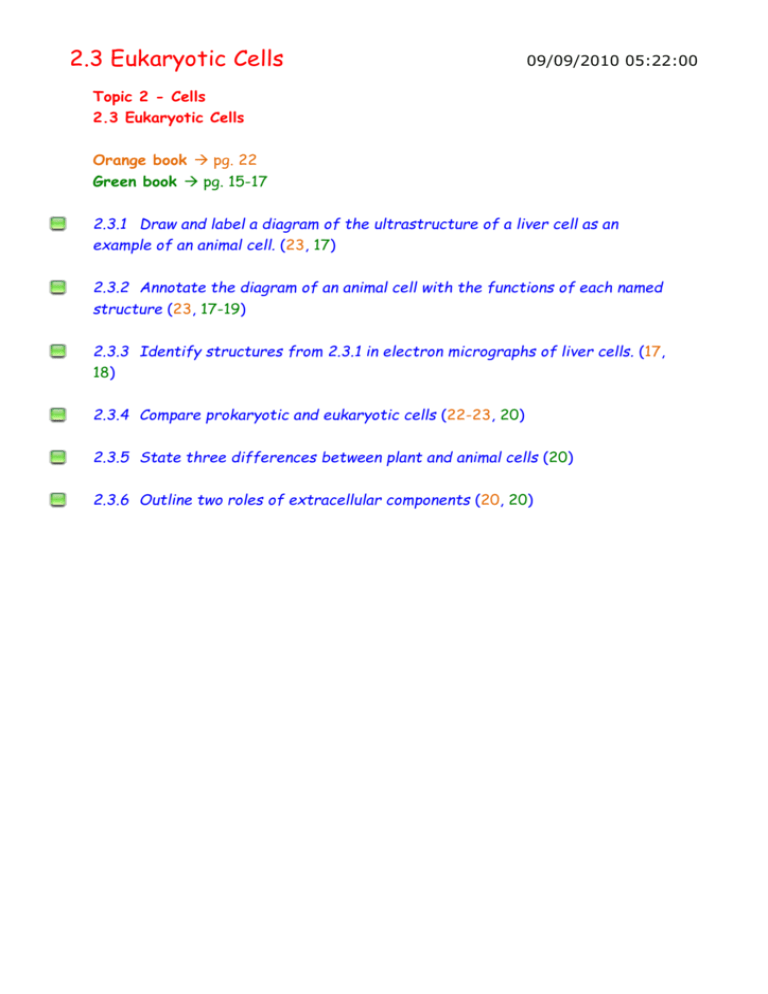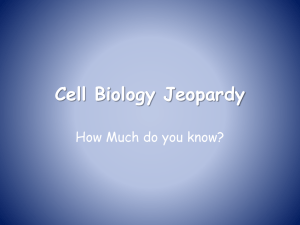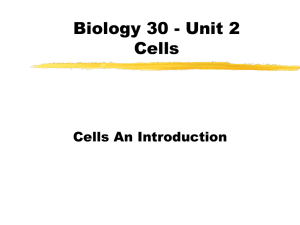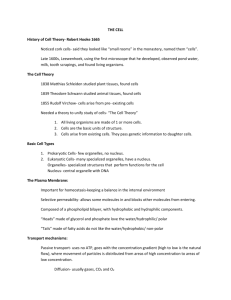2.3 Eukaryotic Cells
advertisement

2.3 Eukaryotic Cells 09/09/2010 05:22:00 Topic 2 - Cells 2.3 Eukaryotic Cells Orange book pg. 22 Green book pg. 15-17 2.3.1 Draw and label a diagram of the ultrastructure of a liver cell as an example of an animal cell. (23, 17) 2.3.2 Annotate the diagram of an animal cell with the functions of each named structure (23, 17-19) 2.3.3 Identify structures from 2.3.1 in electron micrographs of liver cells. (17, 18) 2.3.4 Compare prokaryotic and eukaryotic cells (22-23, 20) 2.3.5 State three differences between plant and animal cells (20) 2.3.6 Outline two roles of extracellular components (20, 20) 2.3.1 Animal Cell 09/09/2010 05:22:00 2.3.1 Draw and label a diagram of the ultrastructure of a liver cell as an example of an animal cell. Drawing should show free ribosomes, rough endoplasmic reticulum, lysosome, Golgi apparatus, mitochondria and nucleus. Orange book pg. 23 Green book pg. 17 To do: Colour in the handout of the animal cell Visit the two websites: Typical Animal Cell http://www.wisc-online.com/objects/index_tj.asp?objID=AP11403 Animal Cell Animation http://www.cellsalive.com/cells/3dcell.htm Typical Animal Cell Whereas prokaryotic cells occur in the bacteria, eukaryotic cells occur in organisms such as algae, protozoa, fungi, plants and animals. Eukaryotic cells range in diameter from 5 to 100 m. Also, usually noticeable is the nucleus in the cytoplasm. Other organelles may be visible in the cell if you have a microscope with high enough magnification and resolution. Organelles are non-cellular structures that carry out specific functions (abit like organs in multicellular organisms). Different types of cell often have different organelles. These structures bring about compartmentalization in eukaryotic cells. This is not a characteristic of prokaryotic cells. Compartmentalization allows chemical reactions to be separated. This is especially important when the adjacent chemical reactions are incompatible. It also allows chemicals for specific reactions to be isolated. This isolation results in increased efficiency. 2.3.2 Structure & Function 09/09/2010 05:22:00 2.3.2 Annotate the diagram of an animal cell with the functions of each named structure Orange book pg. 23 Green book pg. 17-19 To do: You have many organelles to learn. The best way to do this is to use all the resources and tackle one organelle at a time. Visit the websites: Animal Cell Organelles http://www.wisc-online.com/objects/index_tj.asp?objID=AP11604 Cell Animation http://www.cellsalive.com/cells/3dcell.htm Cell Structure and Processes http://www.tvdsb.on.ca/westmin/science/sbi3a1/Cells/cells.htm Use the notes below to label and annotate the handout of a eukaryotic cell Complete the handout “2.3.2 The Organelles of a Eukaryotic Cell Summary Table” Summary Complete the “Organelle Quiz” on the following website: http://www.zerobio.com/target_practice_quiz/target_practice_quiz_cells.htm Organelles of Eukaryotic Cells Endoplasmic reticulum Ribosomes Lysosomes (not usually in plant cells) Golgi apparatus Mitochondria Nucleus Chloroplasts (plant and algae) Centrosomes (all eukaryotes but centrioles not found in higher plants) Vacuoles Rough Endoplasm The endoplasmic reticulum (ER) is an extensive network of tubules or channels that extend almost everywhere in the cell from the nucleus to the plasma membrane. Its structure enables it function which is the transportation of materials throughout the internal region of the cell. RER is studded with numerous ribosomes, which give it its rough appearance. The ribosomes synthesise proteins, which are processed in the RER (e.g. by enzymatically modifying the polypeptide chain, or adding carbohydrates), before being exported from the cell via the Golgi Body. These proteins may become parts of membranes, enzymes, or even messengers between cells. Ribosomes These are the smallest and most numerous of the cell organelles (however, they do not have an exterior membrane) and are the sites of protein synthesis. They are composed of protein and RNA, and are manufactured in the nucleolus of the nucleus. Ribosomes are either found free in the cytoplasm, where they make proteins for the cell's own use, or they are found attached to the rough endoplasmic reticulum, where they make proteins for export from the cell. They are often found in groups called polysomes. All eukaryotic ribosomes are of the larger, "80S", type. (Prokaryotic ribosomes are the “70S” type). Lysosomes Lysosomes are intracellular digestive centres that arise from the Golgi apparatus. The lysosome lacks any internal structures. They are sacs bounded by a single membrane that contain many different enzymes. The enzymes are all hydrolytic and catalyse the breakdown of protein, nucleic acids, lipids and carbohydrates. Lysosomes fuse with old or damaged organelles from within the cell to break them down so that recycling of the components may occur. Also, lysosomes are involved with the breakdown of materials that may be brought into the cell by phagocytosis. The interior of a functioning lysosome is acidic. This acidic condition is necessary for the enzymes to hydrolyse large molecules. Golgi Apparatus Another series of flattened membrane vesicles, formed from the endoplasmic reticulum. This organelle functions in the collection, packaging, modification and distribution of materials synthesised in the cell. It often involves transporting proteins from the RER to the cell membrane for export. Parts of the RER containing proteins fuse with one side of the Golgi body membranes, while at the other side small vesicles bud off and move towards the cell membrane, where they fuse, releasing their contents by exocytosis. This organelle is found in high numbers in glandular cells such as those in the pancreas, which manufacture and secrete substances. Mitochondria This is a sausage-shaped organelle (8µm long – close to the size of a prokaryotic cell), and is where aerobic respiration takes place in all eukaryotic cells. Mitochondria are surrounded by a double membrane: the outer membrane is simple and quite permeable, while the inner membrane is highly folded into cristae, which give it a large surface area. The inner membrane is studded with stalked particles, which are the site of ATP synthesis. An area called the inner membrane space lies between the two membranes. The space enclosed by the inner membrane is called the mitochondrial matrix, and contains small circular strands of DNA. It also contains ribosomes. Nucleus and Nuclear Envelope This is the largest organelle. Surrounded by a nuclear envelope, which is a double membrane allowing compartmentalization of the eukaryotic DNA, thus providing an area where DNA can carry out its functions and not be affected by processes occurring in other parts of the cell. The nuclear membrane does not provide complete isolation as it has numerous pores - large holes containing proteins that control the exit of substances such as RNA and ribosomes from the nucleus. The interior is called the nucleoplasm, which is full of chromatin - a DNA/protein complex containing the genes. During cell division the chromatin becomes condensed into discrete observable chromosomes. The nucleolus is a dark region of chromatin, involved in making ribosomes. The following are not specifically listed on your syllabus but are worth having knowledge of. Cytoplasm or Cytosol This is the solution within the cell membrane. It contains enzymes for glycolysis (part of respiration) and other metabolic reactions together with sugars, salts, amino acids, nucleotides and everything else needed for the cell to function. Vacuoles These are membrane-bound sacs containing water or dilute solutions of salts and other solutes. Most cells can have small vacuoles that are formed as required, but plant cells usually have one very large permanent vacuole that fills most of the cell, so that the cytoplasm (and everything else) forms a thin layer round the outside. Plant cell vacuoles are filled with cell sap, and are very important in keeping the cell rigid, or turgid. Some unicellular protoctists have feeding vacuoles for digesting food, or contractile vacuoles for expelling water. Microvilli These are small finger-like extensions of the cell membrane found in certain cells such as in the epithelial cells of the intestine and kidney, where they increase the surface area for absorption of materials. They are just visible under the light microscope as a brush border. 2.3.3 Liver cells 09/09/2010 05:22:00 2.3.3 Identify structures from 2.3.1 in electron micrographs of liver cells. Orange book pg. 23 Green book pg. 17-18 To do: Carefully examine the false-colour TEM of part of a liver cell. Locate as many of the structures of an animal cell as you can. List these below the diagram. On the handout of the same TEM of part of a liver cell, label and annotate the structures you can identify. 2.3.4 Comparison Prokaryotic vs Eukaryotic09/09/2010 05:22:00 2.3.4 Compare prokaryotic and eukaryotic cells Orange book pg. 22-23 Green book pg. 20 To do: Not much choice but to LEARN it Visit each of the websites: Cell Animation http://www.cellsalive.com/cells/3dcell.htm Comparison of Cells http://www.wiley.com/legacy/college/boyer/0470003790/animations/cell_stru cture/cell_structure.htm Prokaryotic vs. Eukaryotic http://www.biology.ualberta.ca/facilities/multimedia/index.php?Page=253 You should be able to complete the following animations: Comparing Prokaryotic and Eukaryotic Cells Study the table below Summary Complete the handout: “Eukaryote vs Prokaryote Worksheet” Summary of Differences between Prokaryotic and Eukaryotic Cells If you are asked to state the similarities between the two types of cells, you should be certain to include the following: both types of cell have some sort of outside boundary that always involves a plasma membrane both types of cells carry out all the functions of life DNA is present in both cell types 2.3.5 Plant vs Animal 09/09/2010 05:22:00 2.3.5 State three differences between plant and animal cells Orange book pg. not covered Green book pg. 20 To do: Not much choice but to LEARN it Visit each of the websites: Typical Animal Cell http://www.wisc-online.com/objects/index_tj.asp?objID=AP11403 Animal Cell Animation http://www.cellsalive.com/cells/3dcell.htm Plant Cell Animation http://www.cellsalive.com/cells/3dcell.htm Study the tables below Summary construct a table in your green exercise books to make a comparison of plant and animal cells – use KEY words only in your comparison Complete the questions at the end of the document in your green exercise books. Comparison of Plant and Animal Cells Plant Cells Animal Cells Exterior of cell includes an outer cell wall with a plasma membrane just inside Exterior of cell includes only a plasma membrane. There is no cell wall. Chloroplasts are present in the There are no chloroplasts cytoplasm Possess large centrally located vacuoles Vacuoles are usually not present or are small Store carbohydrates as starch Store carbohydrates as glycogen Do not contain centrioles within a centrosome area Contain centrioles within a centrosome area Because a rigid cell wall is present, this Without a cell wall, this cell is flexible cell type has a fixed, often angular, and more likely to be a rounded shape shape Most cellular organelles are present in both plant and animal cells. When an organelle is present in both types of cell, it usually has the same structure and function. For example, both cell types contain mitochondria that possess cristae, matrix and the double membrane. Also, in both cell types, the mitochondria function in the production of ATP for use by the cell. The outermost region of various cell types is often unique, as shown in the following table: Cell Components of Outer Layer Bacteria Cell wall of peptidoglycan Capsule of polysaccharides Plants Cellulose cell wall Animals NO cell wall Plasma membrane secretes a mixture of sugar and proteins called glycoproteins that forms the extracellular matrix Typical Animal Cell Typical Plant Cell Questions 1. The diagram below shows the structure of a liver cell as seen using an electron microscope. a. Name parts labeled A, B, C and D. (4) b. Give the function of each part you have labeled. (4) 2. Copy and complete the following passage about the palisade cells of a leaf and write on the dotted lines the most appropriate word or words to complete the passage. (5) The palisade cell is typical of plant cells in that it has three structures, .......................................................... , ................................................................. and ......................................................, none of which is present in animal cells. In common with animal cells, plant cells (such as palisade cells) have membranebound organelles which are not present in.............................................. cells. In a leaf, palisade cells are grouped together as a layer just below the epidermis forming a ....................................................., the function of which is to carry out photosynthesis. 3. Some cells were broken up and the organelles that they contained were separated by ultracentrifugation. The drawing shows three of the types of organelle which were obtained. a. The cells were all the same type. Which of the cells A to D listed below might they have been? (1) A bacterial cells B red blood cells C D cells from a plant leaf epithelial cells from the lung b. Explain why only organelle X appeared in the sediment when the broken up cells were centrifuged at the lowest speed. (1) c. Give the function of: (20 i. organelle Y; ii. organelle Z 4. The diagram represents the structure of an animal cell as it would appear when seen with an electron microscope. a. Name one structure: i. that is present in this cell but would not be in a bacterial cell; (1) ii. that is not present in this cell but may be present in a bacterial cell. (1) b. Describe one function of the organelle labelled X. (1) 5. The drawing shows part of an animal cell. a. Name feature X.(1) b. Describe the function of organelle Y. (1) c. Describe one way in which the function of organelle Z is related to the function of organelle Y. (2) 6. The diagram shows part of a cell that secretes enzymes. a. Give one piece of evidence, visible in the diagram, which shows that this cell is a eukaryotic cell. (1) b. Name the process which is occurring at point X on the diagram. (1) 2.3.6 Extracellular Components 09/09/2010 05:22:00 2.3.6 Outline two roles of extracellular components Orange book pg. 20 Green book pg. 20 To do: Short one Read the relevant information below and in the green book. Very brief summary in green exercise books The extracellular matrix (ECM) of many animal cells is composed of collagen fibres plus a combination of sugars and proteins called glycoproteins. These form fibre-like structures that anchor the matrix to the plasma membrane. This strengthens the plasma membrane and allows attachment between adjacent cells. The ECM allows for cell-to-cell interaction, possibly altering gene expression and bringing about coordination of cell action within the tissue. Many researchers think the ECM is involved in directing stem cells to differentiate. Cell migration and movement also appear to be, at least partially, the result of interactions in this area.









